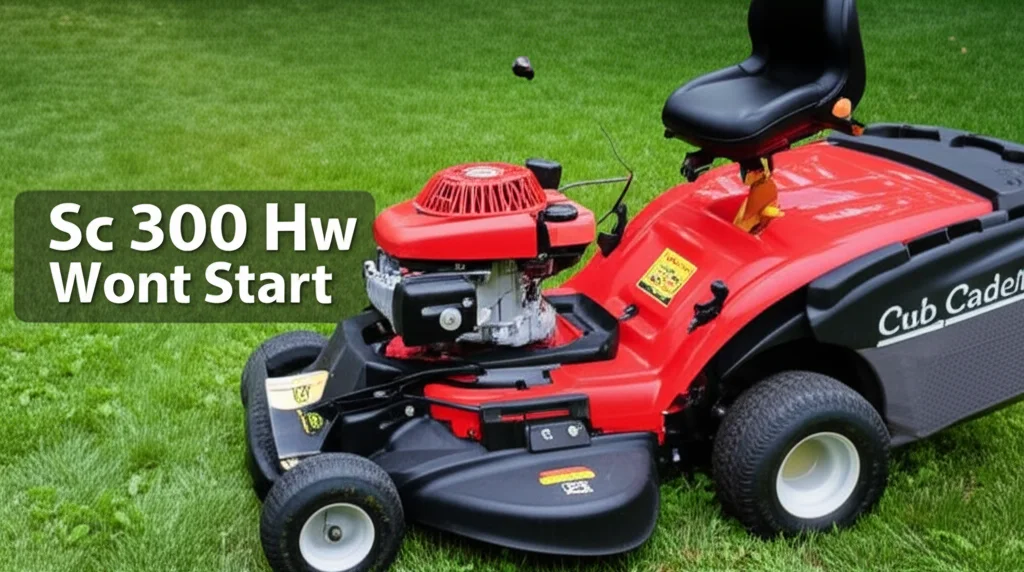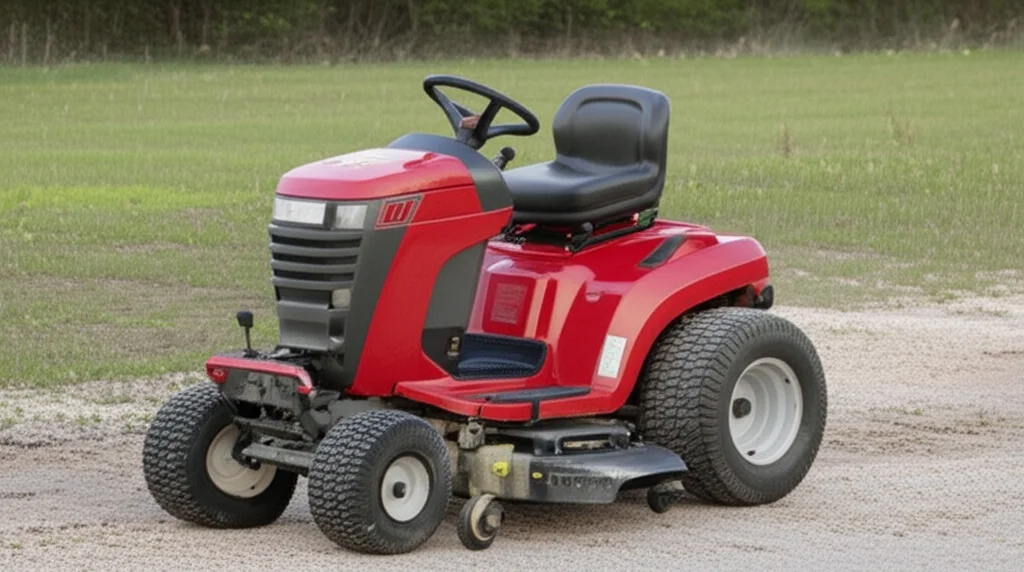· Lawn Mower Repair · 7 min read
Husqvarna Riding Mower Turns Over But Wont Start

Husqvarna Riding Mower Turns Over But Won’t Start: A Comprehensive Guide
Is your Husqvarna riding mower turning over, but refusing to actually start? This is a common frustration for homeowners, and thankfully, often a fix you can tackle yourself. A mower that cranks but doesn’t fire up usually points to a fuel or ignition problem. This article will walk you through the most likely causes, providing clear steps to diagnose and resolve the issue, so you can get back to enjoying a perfectly manicured lawn. We’ll cover everything from simple checks to more involved troubleshooting.
Takeaway:
- Check the fuel system for blockages or old fuel.
- Inspect the spark plug for fouling or damage.
- Verify the safety switches are functioning correctly.
- Consider a carburetor cleaning if other solutions fail.
Quick Answer:
If your Husqvarna riding mower turns over but won’t start, the most common culprits are a lack of fuel reaching the engine, a faulty spark plug, or a problem with the safety switches. Checking these areas systematically will usually pinpoint the issue and get your mower running again.
1. Fuel System Fundamentals: Is Fuel Reaching the Engine?
A mower turning over but not starting often indicates a fuel delivery problem. Your engine needs a proper air-fuel mixture to ignite. Start by ensuring you have fresh fuel in the tank; old gas can degrade and clog the system. Gasoline can lose its volatility over time, especially if it contains ethanol.
Here’s how to check the fuel system:
- Fuel Shut-Off Valve: Make sure the fuel shut-off valve is open. It’s usually located near the fuel tank.
- Fuel Line: Inspect the fuel line for kinks or obstructions.
- Fuel Filter: A clogged fuel filter is a frequent offender. Replace it if it appears dirty. You can find replacement filters easily online or at your local hardware store.
- Carburetor Issues: If the fuel is flowing but the mower still won’t start, the carburetor might be clogged. A dirty carburetor prevents the proper mixing of fuel and air. You might need to clean or rebuild the carburetor. Consider checking out this guide on how to clean a carburetor on a Husqvarna riding lawn mower for detailed instructions.
2. Spark Plug Inspection: The Ignition Source
If fuel is reaching the engine, the next step is to check the spark plug. The spark plug provides the spark needed to ignite the air-fuel mixture. A fouled or damaged spark plug won’t produce a spark, preventing the engine from starting.
Here’s what to do:
- Remove the Spark Plug: Carefully disconnect the spark plug wire and remove the spark plug using a spark plug wrench.
- Visual Inspection: Look for signs of fouling (carbon buildup), cracks, or damage.
- Spark Test: Reconnect the spark plug wire to the spark plug. Ground the spark plug against the engine block and pull the starter cord. You should see a strong, blue spark. If the spark is weak or nonexistent, replace the spark plug. You can also find helpful information on how to clean a lawn mower spark plug.
- Gap Check: Ensure the spark plug gap is set to the manufacturer’s specifications (usually around 0.030 inches).
3. Safety Switch System: Preventing Accidental Starts
Husqvarna riding mowers are equipped with multiple safety switches designed to prevent accidental starts. These switches include the seat switch, the brake/clutch switch, and the blade engagement switch. If any of these switches are faulty, the mower won’t start, even if it cranks.
- Seat Switch: Ensure you are firmly seated in the seat while attempting to start the mower. The seat switch must be engaged.
- Brake/Clutch Switch: Make sure the brake or clutch pedal is fully depressed.
- Blade Engagement Switch: The blade engagement lever should be disengaged (in the “off” position) when starting the mower.
- Testing Switches: Testing these switches often requires a multimeter. If you’re not comfortable with electrical testing, it’s best to consult a qualified mechanic.
4. Air Filter Check: Ensuring Proper Airflow
While less common, a severely clogged air filter can restrict airflow to the engine, making it difficult to start. The engine needs a proper air-fuel mixture, and a restricted air filter can disrupt that balance.
- Locate the Air Filter: The air filter is usually housed in a plastic enclosure on the side or top of the engine.
- Inspect the Filter: Remove the air filter and inspect it for dirt and debris.
- Cleaning or Replacement: If the filter is dirty, try cleaning it by tapping it gently to remove loose debris. If it’s heavily soiled or damaged, replace it with a new one. You can find guides on how to clean an air filter on a lawn mower.
5. Carburetor Cleaning: A Deeper Dive
If you’ve checked the fuel system, spark plug, and safety switches, and the mower still won’t start, a more thorough carburetor cleaning might be necessary. The carburetor is responsible for mixing air and fuel, and it can become clogged with varnish and deposits over time.
- Disassembly: Carefully disassemble the carburetor, taking note of the location of all parts.
- Cleaning: Use carburetor cleaner to thoroughly clean all passages and jets.
- Reassembly: Reassemble the carburetor carefully, ensuring all parts are properly installed.
- Professional Help: If you’re not comfortable disassembling and cleaning the carburetor yourself, consider taking it to a qualified mechanic. You can also find a guide on how to clean a carburetor on a push mower which has similar principles.
6. Low Compression: A More Serious Issue
Low compression can also prevent an engine from starting. Compression is the force created when the piston moves up and down in the cylinder. If the compression is too low, the engine won’t have enough power to ignite the air-fuel mixture.
- Compression Test: A compression test requires a special tool and some mechanical knowledge. It’s best left to a qualified mechanic.
- Possible Causes: Low compression can be caused by worn piston rings, a damaged cylinder, or a leaky valve.
7. Engine Starts with Starter Fluid But Won’t Stay Running
If your Husqvarna engine briefly starts when sprayed with starting fluid but immediately dies, this strongly suggests a fuel delivery problem. The starter fluid bypasses the normal fuel system, providing a temporary burst of combustible mixture. This confirms the ignition system is working, but the engine isn’t getting fuel from the tank, carburetor, or fuel pump. You can find more information on this issue at engine starts with starter fluid but won’t stay running.
FAQ: Common Questions About Husqvarna Mowers That Won’t Start
Q: Why won’t my Husqvarna riding mower start after sitting for a long time?
A: Old fuel is the most likely culprit. Gasoline degrades over time, especially if it contains ethanol. Drain the old fuel, replace the fuel filter, and add fresh fuel. You may also need to clean the carburetor if it’s clogged with varnish.
Q: What does a clogged fuel filter do to a lawn mower?
A: A clogged fuel filter restricts the flow of fuel to the engine, causing it to run poorly or not start at all. It’s a simple and inexpensive part to replace, so it’s a good place to start when troubleshooting starting problems.
Q: How often should I replace the spark plug on my Husqvarna riding mower?
A: Generally, you should replace the spark plug every 100 hours of operation or annually, whichever comes first. However, inspect the spark plug regularly and replace it sooner if it shows signs of fouling or damage.
Q: Can a dead battery cause a mower to turn over but not start?
A: While a dead battery usually prevents the mower from turning over at all, a weak battery can sometimes provide enough power to crank the engine but not enough to properly engage the ignition system. Ensure your battery is fully charged and in good condition.
Conclusion: Getting Your Husqvarna Back in Action
A Husqvarna riding mower that turns over but won’t start can be frustrating, but with a systematic approach, you can often diagnose and fix the problem yourself. Remember to start with the simple checks – fuel level, fuel shut-off valve, and safety switches – before moving on to more involved troubleshooting like spark plug inspection and carburetor cleaning. By following the steps outlined in this guide, you’ll be well on your way to getting your mower running smoothly and enjoying a beautifully maintained lawn. Don’t hesitate to consult a qualified mechanic if you’re unsure about any of these procedures.
- Husqvarna Riding Mower
- Riding Mower Repair
- Lawn Mower Troubleshooting


